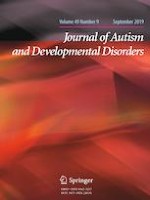11-06-2019 | Original Paper
Concurrent Social Communication Predictors of Expressive Language in Minimally Verbal Children and Adolescents with Autism Spectrum Disorder
Gepubliceerd in: Journal of Autism and Developmental Disorders | Uitgave 9/2019
Log in om toegang te krijgenAbstract
Numerous studies have investigated the predictors of language in pre-verbal toddlers and verbally fluent children with autism spectrum disorder (ASD). The present study investigated the concurrent relations among expressive language and a set of empirically-selected social communication variables—joint attention, imitation, and play—in a unique sample of 37 minimally verbal (MV) children and adolescents with ASD. Results revealed that imitation and play were significantly correlated with expressive language, even when controlling for non-verbal IQ, but joint attention was not. Imitation was the only predictor variable to reach significance within the regression model. Findings demonstrate that predictors of expressive language vary for subpopulations of the autism spectrum, and have broader implications for intervention design for older, MV individuals with ASD.
